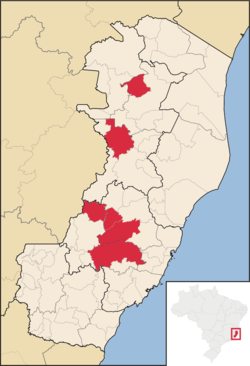Brazilian German
The German-based varieties spoken by German Brazilians together form a significant minority language in Brazil. "Brazilian German" is strongly influenced by Portuguese and to a lesser extent by Italian dialects as well as indigenous languages. German dialects are particularly strong in Brazil's South and Southeast Regions. According to Ethnologue, ca. 3 million people in Brazil speak Riograndenser Hunsrückisch, 1.5 million Standard German (likely including Pommersch), and 8,000 Plautdietsch.[1]
German speakers from Germany, Switzerland and Austria make up the largest group of immigrants after Portuguese and Italian speakers. They tended to preserve their language longer than the speakers of Italian, which is closer to Portuguese. Consequently, German was the second most common family language in Brazil at the 1940 census. However, even in areas that are still dominated by German speakers, most are bilingual. Today, German is increasingly cultivated as a cultural heritage, and several municipalities have recently given co-official status with Brazilian Portuguese to one Brazilian variant or another of it.
Riograndenser Hunsrückisch is the most significant variant, and the term is sometimes used so as to include all forms of Brazilian German. It is particularly well represented in the two southernmost states, Rio Grande do Sul and Santa Catarina. But especially in Espírito Santo there are significant pockets whose dialect is based on East Low German (Pommersch),[2] and some other dialects can be found locally due to 20th century immigration.
Hunsrückisch
Brazilian Hunsrückisch, a dialect of the High German language, is also referred to as Riograndenser Hunsrückisch (or Hunsrik) after the country's southernmost state, Rio Grande do Sul. But it is also strongly represented in Santa Catarina, where the local variant is referred to as Katharinensisch, and in Paraná. Together, these three states form Brazil's South Region. The area attracted significant immigration from German-speaking countries. Overall, it is particularly well developed in comparison to the rest of Brazil.
German immigration to Rio Grande do Sul started in 1824.[3] The German workers and settlers came from many different regions, but especially from the poor regions Hunsrück and nearby Palatinate. The German dialects began to mix with each other, adopting elements of the languages spoken by other immigrants, to form varieties that differed from municipality to municipality, often from family to family, and which had no relation to the dialect lines in Germany.[4] However, in most places the Hunsrück dialect proved dominant.
Initially, the immigrants had to organize their own school system,[5] but this was to change. Due to lack of exposure – from 1938 till 1961, German was not even taught at higher schools.[6] – Standard German became restricted to formal contexts such as church, whereas all daily interactions happened either in dialect or in Portuguese, from which the required words for innovations were also taken.[7]
Speakers of Hunsrückisch are typically bilingual with Portuguese, but are not necessarily familiar with Standard German. The elementary school of Santa Maria do Herval, a municipality in Rio Grande do Sul with a population of roughly 6,000, teaches Hunsrückisch and uses a new orthography for this which is closer to Portuguese than to Standard German conventions. However, linguists in Brazil criticize this detachment and demand a closer orthographic tie between Hunsrik and Standard German[8]
- Co-official status[9]
Pommersch
Pommersch, a dialect of the Low Saxon language, is spoken in many places in southeastern and southern Brazil:
- Projeto de Educação Escolar Pomerana, founded 2004 by teachers and five municipalities in Espírito Santo (Santa Maria de Jetibá, Laranja da Terra, Vila Pavão, Domingos Martins, Pancas). Education in (Brazilian?) Pommersch.[10]
- Pommersch spoken in Rondônia since 1970.[10]
- In Santa Leopoldina, first European settlement in Espírito Santo, the descendants of immigrants from Switzerland and Luxembourg now speak Pommersch.[10]
- Santa Maria de Jetibá (previously part of Santa Leopoldina) is Brazil's center of Pommeranian culture with 90% (ethnic?) Pommeranians.[10]

- Co-official status[9]
- Espírito Santo
- Santa Catarina
- Rio Grande do Sul
Other German dialects in Brazil
- Plautdietsch, spoken by ethnic German Mennonites from the former Soviet Union (since the 1930s).[12][13]
- Tyrol Austro-Bavarian dialect and Vorarlberg Alemannic in Dreizehnlinden (since 1933).[14]
- Danube Swabian in Guarapuava (since 1951).[15]
Dutch closely related to German, are also spoken in Brazil by Dutch Brazilians and some Brazilian Jews.
See also
- List of territorial entities where German is an official language
- Geographical distribution of German speakers
- Languages of Brazil
References
- ^ "Ethnologue". Ethnologue. Retrieved 4 August 2015.
- ^ [1] Archived November 20, 2012, at the Wayback Machine
- ^ Altenhofen, Cléo Vilson: Hunsrückisch in Rio Grande do Sul, Franz Steiner Verlag, Stuttgart 1996, p. 24.
- ^ Altenhofen, p. 42.
- ^ Altenhofen, p. 69.
- ^ Altenhofen, p. 38.
- ^ Altenhofen, p. 45.
- ^ "Brasilien: Hunsrücker Platt wird zweite Amtssprache". volksfreund.de. 2014-03-27. Retrieved 2015-08-11.
- ^ a b "IPOL realizará formação de recenseadores para o censo linguístico do município de Antônio Carlos-SC". Retrieved 4 August 2015.
- ^ a b c d Bost, Bodo: Pommersche Sprache erlebt Renaissance in Brasilien. VDA Globus 1/2010.
- ^ "Pomerano!? | Língua Portuguesa". Lpniceia.wordpress.com. 2008-12-27. Retrieved 2015-08-11.
- ^ Göz Kaufmann (2004). "Eine Gruppe - Zwei Geschichten - Drei Sprachen. Rußlanddeutsche Mennoniten in Brasilien und Paraguay". Zeitschrift für Dialektologie und Linguistik. Franz Steiner Verlag: 257–306. JSTOR 40505042.
- ^ "Mennoniten - junge gemeinde - Mennoniten in Lateinamerika / Paraguay / Brasilien / Bolivien / Mexiko / Südamerika". Jungegemeinde.de. 2007-03-18. Retrieved 2015-08-11.
- ^ René Laglstorfer. "Schuhplattln auf Brasilianisch". derStandard.at. Retrieved 4 August 2015.
- ^ "Fundação Cultural Suábio-Brasileira". Retrieved 4 August 2015.
